We may not have the course you’re looking for. If you enquire or give us a call on 0800 446148 and speak to our training experts, we may still be able to help with your training requirements.
Training Outcomes Within Your Budget!
We ensure quality, budget-alignment, and timely delivery by our expert instructors.

Project Scope is everything for a project; it defines its purpose and objectives and shapes the end product. It could result in catastrophic consequences if it is not properly defined as per the client's expectations. Using a project management procedure like the PRINCE2 Project Scope Methodology can help you define Project's Scope properly.
Project Management is the stepping stone for an organisation's success. Any hiccups in Project Management could jeopardise the entire project. A project is a temporary work with initiation and closure phases. The success of all these phases depends on the Project Scope. It is entirely the project manager's responsibility to ensure that there's no disruption during these phases.
Managing projects is not an easy feat. Efficient Project Management requires proper planning, which is where the Project Scope can help. A Project Scope enables you to define the project's purpose and prevents any hurdles. Learn about the PRINCE2 Project Scope in this blog, along with its importance and a detailed explanation of its scope management plan.
Table of Contents
1) Introduction to Project Scope Management
2) Why is it important?
3) How does Project Scope help Project Managers
4) What are the steps used in Project Scope Management?
5) Effective Tips and Tricks for Project Scope Management
6) Conclusion
Introduction to Project Scope Management
Project Scope management is the procedure for determining the project's purpose, goals, activities, targets, cost and timelines. It is also essential for determining the documents that outline these details. It is not uncommon for a project to have changes midway. So, determining the scope immediately ensures that these changes don't take the project off course. Plus, it also helps the team to implement these changes conveniently.
In today's competitive world, results matter, and results will dictate success and failure. The primary objective of most projects is fulfilling the client's expectations. Some methodologies would give importance to the process and not focus on the deliverables. Not focusing on the product may impact the quality of the product negatively.
Using a Project Management methodology like PRINCE2 can help you overcome this issue. PRINCE2 primarily focuses on the final product and will help project managers establish Project Scope. With PRINCE2, you can define the Project Scope, which puts greater importance on the deliverables. So, the final product's quality will be high quality and will likely meet client expectations.
Sign up for PRINCE2® Foundation & Practitioner Training Course and learn everything about Project Management
Why is it important?
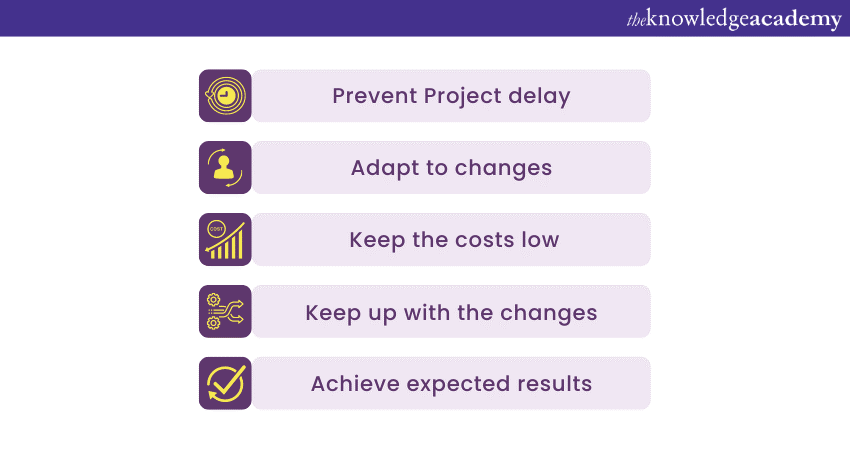
Meeting the expectations of clients and shareholders can be a daunting task. It is the Project Manager's responsibility to ensure that. So, by defining a scope for the project, it becomes easy for Project managers to keep up with the deadline. They are responsible for ensuring the scope is followed throughout the project's lifecycle. A clearly defined Project Scope is very important because it can prevent some problems like:
a) When the project is not completed within the specified deadline
b) Difficulty in adapting to ever-changing needs and environment
c) When the estimated cost of the project exceeds the budget
d) Difficulty in changing the flow of the project halfway
e) Most importantly, when the result falls below expectations and fails to achieve its purpose
A well-defined Project Scope management will determine the time it takes to complete the project, the estimated budget, and the amount of labour involved. It can effectively determine the resources necessary for completing the project and determine what is irrelevant. It could even discover the areas where you can expect changes halfway through.
Project Scope statement
Almost all the project management methodologies will have a Project Scope statement. Creating this statement is one of the first tasks in Project Scope management. These statements can mitigate risks and streamline the project flow. So, it should be well documented and cover all the project areas.
a) Work specification: The Project Scope can help the clients stay updated on the project's work. So, it should be easy to understand and specify on project's initiation and closure.
b) Final product: Since the client reads the project statement, it should clearly specify the final deliverables.
c) The rationalisation for the project: The project statement should clearly define the project use cases and inform the client. You can avoid future conflicts by properly communicating these business cases with the client.
d) Limitations: A project can have many limitations if they don't affect the deliverables. However, if it does affect the deliverables, it could lead to conflicts with the client.
e) Additions and Omissions: Sometimes, you may need to add certain resources and remove some items from your project. Mentioning these changes in the scope document can prevent disagreements with the client.
How does Project Scope help Project Managers?
Creating a Project Scope needs proper planning and communication among everyone involved in project management. This will help everyone involved to understand the project's vision as well as help to reach a common consensus. The project's goal can be easily achieved using PRINCE2 Project Scope templates. Apart from this, using clear Project Scope documentation and Project Scope report can also help. Above all, it is necessary to clearly understand these documents and reports to achieve the project's goals.
a) Preventing the challenges: You can prevent some common challenges in a project with Project Scope management. Plus, the Project Scope should specify what is necessary for the project and what is not. This will help to determine what is added or removed across the project's tenure.
b) Tracking structures: A Project Scope plan can help create tracking structures for handling items that fluctuate from time to time. These items are tracked throughout the project's tenure, and the budget and timeline can be managed effectively if the Project Scope is clearly defined.
c) Budget and timeline: Since it involves various factors, predicting a project's timeline and the cost is very difficult. It would be even more complicated when the project's purpose is unclear. The Project Scope can switch directions sometimes due to miscommunication. This would further add more salt to the wounds, increase operating costs, and increase the schedule.
What are the steps used in Project Scope Management?
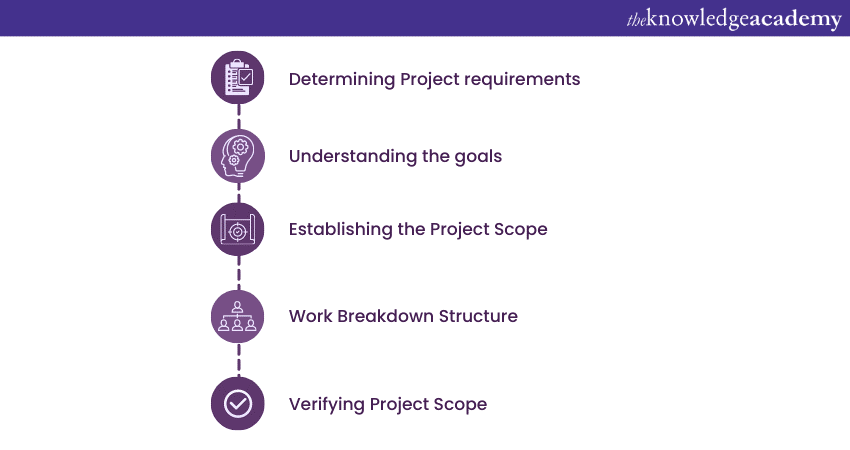
Project Scope is a critical aspect of Project management. The Project Manager has to specify the Project Scope. They can use any project management methodology like PRINCE2, PMBOK or PMP to do that. However, the steps to implement the Project Scope remain unchanged regardless of the methodology. These steps are mentioned below:
Determining the requirements of Project
The first step the project manager needs to do when determining the project requires finding the necessary resources needed for the project. Then they would specify a projected deadline to complete the project. After that, they would establish the likely targets for the project.
When the project's scope is well-defined, the manager can assign roles and responsibilities to everyone within the specified budget and deadline. Once the roles are assigned, it becomes easy for everyone on the team to implement their work. At the same time, it also becomes easy for the project manager to keep track of their team's work.
Realising the Project’s Goals
A project without a scope cannot achieve its target; similarly, a Project Scope without goals will fail to achieve its purpose. The project's goals could be creating a software service or implementing a new service in the organisation. Whatever the goals, maybe they should be defined well in advance. A project can have multiple goals, and it's the manager's responsibility to ensure they are achieved.
Establishing the Project’s Scope
A project cannot be completed without proper resources and procedures to implement the project. So, before creating the Project Scope, it's necessary to determine the following:
a) The goals of the project
b) The timeline it takes to complete the project
c) What resources and components are necessary to complete the project
d) The estimated cost of the project
The above requirements should be determined first to create the project's scope. Once these requirements are identified, it's necessary to identify the project's limitations and the items that are irrelevant to the project. After identifying all these criteria, the project manager can establish the project's scope.
The Project Scope should give a strong sense of purpose to the organisation implementing the project. Having such a strong purpose will surely increase the project's visibility. Apart from this, it can also help redefine how it implements the project methodologies in the future. So, everyone involved in the project needs to clearly understand the project's scope, including the team members, upper management, project board, and shareholders, to avoid disruptions.
Implementing a Work Breakdown Structure
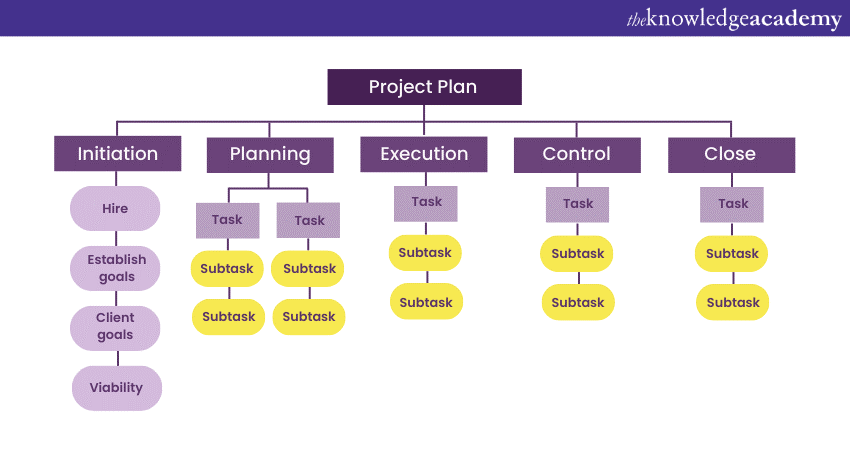
Work Breakdown Structure (WBS) is a project management tool for managing tasks and deliverables in an organised way. It does this by breaking down all the project's processes and procedures into manageable tasks. Then it will create a hierarchical list of the tasks that explains the order in which the tasks should be completed. The main objective of the WBS is to create and identify the project's vision by breaking down its processes.
WBS can be categorised into two categories: Product oriented WBS and Phase oriented WBS.
a) Product-oriented WBS: It breakdowns much of the Project Scope into manageable work packages, deliverables and subtasks. Product-oriented WBS is also known as Deliverable oriented WBS, and Deliverables are the key elements necessary to complete projects successfully.
b) Phase-oriented WBS: It puts the deliverables at the highest priority in the work breakdown structure. It is very similar to the product-oriented WBS; however, it is much more organised. It splits processes into manageable phases like the work packages of product-oriented WBS.
Verifying the Project Scope
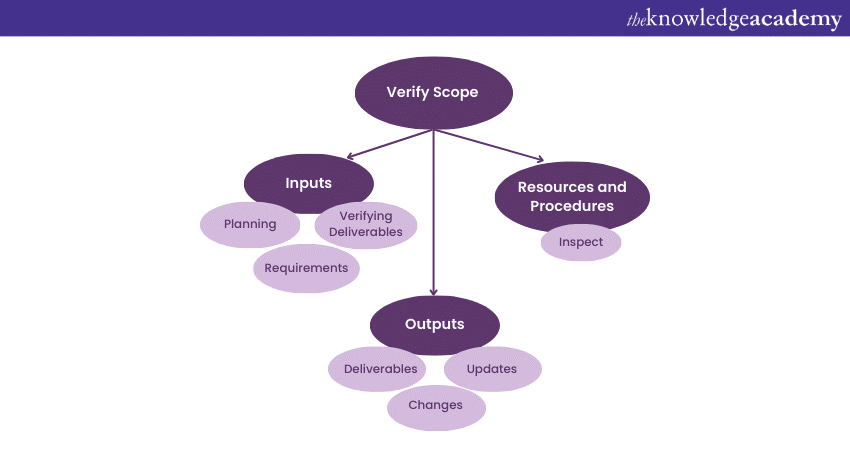
Here the clients and stakeholders will verify whether the deliverables meet the expectations. Moreover, they will also validate the changes along with the project documents. Then they will review the project team’s performance at each phase. This process usually happens during the final stages of every phase. The project manager will start working on the next phase once the client gives their feedback and approve the current phase.
Controlling the Project Scope
As the name implies, this step is all about implementing complete control over all project phases, and it is the final step in Project Scope management. Here, the project's status is observed continuously, and changes will be made based on the observation. These observations and changes are necessary to ensure the project's success.
In this step, the project manager continuously monitors the Project Scope and checks whether any resources are needed. Plus, they will oversee whether the project follows the Project Scope and ensure it doesn't go off track. Apart from this, all changes, suggestions for corrections and pre-emptive measures go through this process.
Sign up for a course on PRINCE2® Foundation and improve your foundational knowledge of Project Management
Effective Tips and Tricks for Project Scope Management
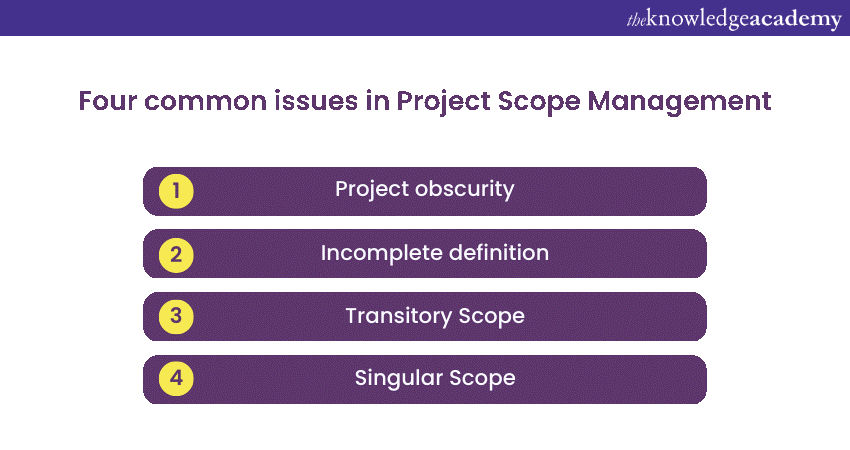
Once a project is initiated, it may run into some familiar problems. However, you can prevent some by carefully changing the Project Scope documentation. The project manager should consider the following issues while making these changes.
Project obscurity
Being open to changes and suggestions is generally a good thing. But regarding Project Scope Management, this openness can conflict with the project's main goal and purpose. Ensure the project's scope is clear and well-defined before starting. By doing that, you can effectively avoid this issue in the first place.
Scrappy definition
When your project's scope is scrappy and incomplete, the project team may have trouble understanding the project's purpose. It may also lead to misunderstandings and confusion, leading to more work than usual. This extra work will impact the project's budget and schedule. To overcome this issue, ensure the Project Scope is defined completely and accurately.
Transitory scope
A transitory scope is the primary reason for Scope creep and could result in late deliveries. If the scope is transitory and changes from time to time, it could cause many issues. You can prevent this when the scope document remains stable and unaltered throughout the project tenure.
Singular Scope
Creating a project requires a lot of effort, and it involves a lot of people. It involves people from the Project team, Project Board, and the clients. When the Project Scope is defined without involving everyone, particularly the clients could cause a lot of misunderstandings. These misunderstandings could impact the project's design and resources, varying from the Project Scope. To overcome this, ensure that the Project Scope document is shared with the client and the client agrees on the Project Scope.
In summary, these tips stress the importance of defining the Project Scope clearly before starting the project. Also, when everyone involved in project management clearly understands the project's vision, there will be less confusion and delays. So, keep these tips in your mind when defining the Project Scope.

Conclusion
We hope you enjoyed reading this article and understood everything on PRINCE2 Project Scope. It empowers project managers with the right tools and resources to manage their projects efficiently, and a clear Project Scope can improve the project outcome.
Signup for our PRINCE2® Training courses and acquire the skills to manage projects efficiently
Frequently Asked Questions
Upcoming Project Management Resources Batches & Dates
Date
 PRINCE2® Foundation & Practitioner Training Course
PRINCE2® Foundation & Practitioner Training Course
Mon 13th Jan 2025
Mon 17th Feb 2025
Mon 17th Mar 2025
Mon 7th Apr 2025
Mon 12th May 2025
Mon 16th Jun 2025
Mon 7th Jul 2025
Mon 4th Aug 2025
Mon 8th Sep 2025
Mon 13th Oct 2025
Mon 17th Nov 2025
Mon 8th Dec 2025







 Top Rated Course
Top Rated Course


 If you wish to make any changes to your course, please
If you wish to make any changes to your course, please


